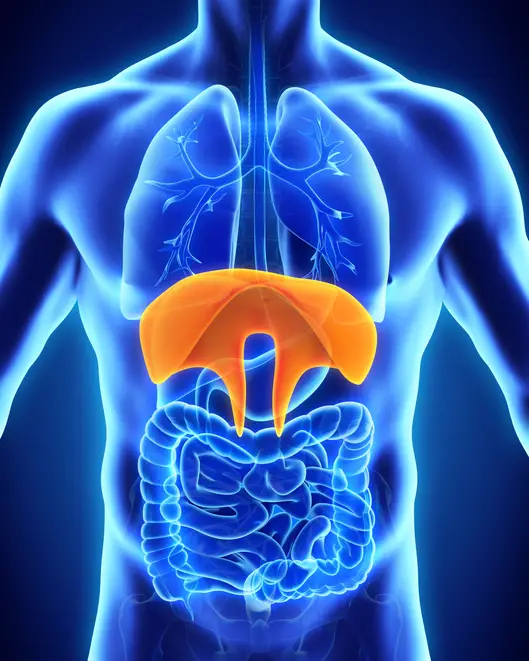Le diaphragm is the main muscle involved in breathing. When it gets blocked, for whatever reason, there are potentially serious consequences. Fortunately, a stuck diaphragm is not entirely irreversible. There are natural solutions to unblock this main respiratory muscle. Details in this article.
Definition and anatomy of the diaphragm
The diaphragm is a inspiratory muscle situated under the lungs. It separates the abdominal cavity and the thorax. It consists of a tendinous central part "the phrenic center" and a muscular part divided into several portions. It is around this center that the muscles move and contract.
On each side, we can distinguish a sternal, costal and vertebral portion:
- The sternal portion: it originates on the posterior surface of the xiphoid appendix and radiates into the phrenic center.
- The costal portion: it has its origin on the internal face of the cartilages at the level of the 7e until the 12e coast. It then meshes with the transverse abdominal muscles.
- The vertebral portion: it is divided into an internal pillar and an external pillar. The right internal pillar finds its origin on the bodies of the 1re until the 4e lumbar vertebra and the left pillar on those of the 1re the 3e lumbar vertebra. As for the external pillar, it arises from two arcades, the arcade of the psoas and the arcade of the square of the loins.
The diaphragm has two asymmetrical hemi-domes with superior convexity (right and left). In the middle line, these are separated by a depression on which the heart rests. The right diaphragmatic dome is located 1 to 2 cm higher than the left dome.
Anatomically, the diaphragm has natural orifices allowing the passage of organs or vessels from one cavity to another (abdominal aorta, inferior vena cava, lymphatic vessels, nerves, etc.). For example, the esophageal orifice allows the passage of the esophagus and the right and left vagus nerves. The innervation of the diaphragm is via the phrenic nerve.
This muscle plays an important role in pulmonary ventilation.
- When it contracts, it creates a depression in the lungs. This is what causes air to enter.
- When it relaxes, it makes possible the lowering of the ribs and the increase of intrathoracic pressure. This is what results in the passive outflow of air (exhalation).
- Just like the heart, the contraction of the diaphragm is reflex: we don't need to think about it to contract it.
They are talking about blocked diaphragm in case of loss of amplitude. However, it is essential to understand is not really blocked in the literal sense. Indeed, if this were the case, breathing would simply become impossible.
Blocked diaphragm: what are the causes?
There are various reasons that can lead to a feeling of blocked diaphragm.
A traumatic cause
The loss of amplitude can be linked to a fall on the back, a physical impact on the stomach, a blow to the ribs, a blow to the lumbar vertebrae.
It can also be the consequence of repeated physical activity in apnea as in the weight room when it is necessary to lift weights. In voluntary apnea, the orifices are blocked. Intra-abdominal and thoracic pressure increases and is finally released abruptly. This causes a water hammer at the diaphragm.
The bad postures
This is particularly the case with prolonged sitting without a break.
Digestive disorders
Certain digestive disorders, such as gastroesophageal reflux disease, can cause the diaphragm to feel blocked. Along with the feeling of chest tightness and difficulty in breathing, there is also nausea and an urge to vomit when taking a deep breath.
Insufficient abdominal strap
When the abdominal strap is too relaxed (not sufficiently muscular), there may be a sensation of a blocked diaphragm. This mainly concerns women who have just given birth and who have not undergone postpartum abdominal rehabilitation (such as hypopressive gymnastics).
Stress and overwork
An emotional shock following a car accident, the loss of a loved one or a job, for example, can contribute to blocking the diaphragm.
Symptoms and consequences of a blocked diaphragm
The symptoms of the blockage of this muscle are multiple. It is most often about tensions or genes at the base of the thorax. There may also be a pain in the phrenic center, opposite the solar plexus, under the sternum. It happens that we notice several symptoms without realizing that they could be problems directly linked to this blockage.
When the diaphragm is contracted, it tends to remain in the down or inspiration position. This causes the organs in the abdomen to compress against the pelvis. This can have various consequences.
- Personalized back pain (lower back pain or upper lumbar pain). The tendons of the diaphragm are at this level, it attaches to the spine with other muscles such as the iliopsoas. If the muscle is too tight, the tendons begin to pull hard on their attachments. This causes stiffness in the back and even pain.
- Personalized feelings of cardiac oppression with a feeling of malaise, palpitations, rapid heartbeat often resulting in long-lasting stress.
- Personalized feelings of oppression : "heaviness on the stomach", "knot in the stomach", or sometimes nausea.
- Personalized reduced breaths as if it were difficult to take a deep breath.
- Personalized cervical tension, even headaches. It is at the level of the cervical that the nerves that innervate it come out.
- Personalized digestive cramps, feelings of bloating, constipation or abdominal tension due to this continuous pressure in the abdomen. The digestion is made difficult and the transit greatly disturbed.
- Un poor venous return, especially in the legs.
- A chronic fatigue, difficulty falling asleep, exacerbated emotivity...
The blocking of the diaphragm exists in two forms: a sustained contraction of the diaphragm (twitching) limiting the respiratory amplitude, or tremors (in the form of hiccups, or the end of crying).
This phenomenon can be very serious for health in general. It can cause a rise in blood pressure, hyperventilation, or even cardiac arrest.
How is the diagnosis made?
To diagnose a blocked diaphragm, the health professional questions the patient and invites him to describe precisely the type of pain he feels. He realizes after a complete clinical examination.
At the end of this examination, additional examinations may prove necessary to rule out any risk of infection and to detect a possible lesion or fracture.
How to treat a blockage of the diaphragm?
The different treatments for relieve a feeling of blocked diaphragm must consider the cause of the disorder.
For less severe cases, just take a warm bath or apply a heating pillow on the painful area. All strenuous activity should be stopped and rest is highly recommended.
The fact of adopting certain good habits makes it possible to prevent pain at the level of the phrenic center.
- Regularly practice rib amplitude exercises. Do it every day, even several times a day, while remaining cautious. This type of exercise improves the general balance of your body. It is excellent for the abdominal strap. This activity strengthens the diaphragm and stimulates it.
- Rest enough. This step is mandatory after each physical activity practiced to help your body get rid of stored fatigue.
- For subjects with frequent anxiety attacks, it is essential to reduce stress. To do this, you have to try to understand where your stress comes from (a move, a promotion, a project to prepare, etc.) and try to manage it. You can seek help from loved ones or a mental health professional. In the long run, you will be able to lower the level of emotional shocks and effectively reduce pain at the level of the phrenic center. Other methods can also help you reduce your state of stress, such as mindfulness meditation, walking, yoga, or breathing exercises.
- For causes related to prolonged poor posture at work: you must rearrange your workstation. You can put a footrest to reduce the angle between your thighs and your trunk, for example.
- After meals, do walking exercises. By taking care of your digestive well-being, you promote both blood circulation from the heart to the various organs.
- Finally, it is essential to do breathing exercises to relax your diaphragm and relax your solar plexus. These exercises help to oxygenate your abdomen well and reduce the onset of anxiety attacks.
Resources
References
https://osteo2ls.com/blog/news-remettre-son-diaphragme-aux-mains-d-un-osteopathe.html


